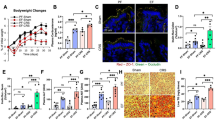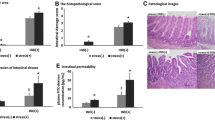Abstract
Alcohol (EtOH) intoxication and burn injury independently activate hypothalamic–pituitary–adrenal (HPA) axis, and glucocorticoids, the end product of the HPA axis, play a role in shaping the immune response under those conditions. By utilizing a rat model of acute EtOH intoxication and burn injury, studies in our laboratory have investigated the role of corticosterone (i.e., glucocorticoids in rodents) in altered intestinal immunity and barrier function following a combined insult of EtOH and burn injury. Results from these studies suggest that EtOH intoxication prior to burn injury augments corticosterone release, which in turn suppresses intestinal T cell function by inhibiting mitogen-activated protein kinase (i.e., p38 and ERK) pathway. Furthermore, we found that corticosterone does not directly alter the intestinal barrier function; rather, it up-regulates interleukin-18, which then directly or indirectly contributes to impaired intestinal barrier function. The loss of intestinal immunity/barrier function may result in increased bacterial translocation and thereby contribute to postinjury pathogenesis, leading to sepsis and organ dysfunction in burn patients as well as in patients with a history of EtOH intoxication.


Similar content being viewed by others
References
Ami K, Kinoshita M, Yamauchi A, Nishikage T, Habu Y, Shinomiya N, Iwai T, Hiraide H, Seki S (2002) IFN-gamma production from liver mononuclear cells of mice in burn injury as well as in postburn bacterial infection models and the therapeutic effect of IL-18. J Immunol 169:4437–4442
Angele MK, Chaudry IH (2005) Surgical trauma and immunosuppression: pathophysiology and potential immunomodulatory approaches. Langenbeck's Arch Surg 390:333–341
Annane D, Cavaillon JM (2003) Corticosteroids in sepsis: from bench to bedside? Shock 20:197–207
Ashwell JD, Lu FW, Vacchio MS (2000) Glucocorticoids in T cell development and function. Annu Rev Immunol 18:309–345
Cabral GA (2005) Lipids as bioeffectors in the immune system. Life Sci 77:1699–1710
Choudhry MA, Ahmad S, Sayeed MM (1995) Role of Ca2+ in prostaglandin E2-induced T-lymphocyte proliferative suppression in sepsis. Infect Immun 63:3101–3105
Choudhry MA, Uddin S, Sayeed MM (1998) Prostaglandin E2 modulation of p59fyn tyrosine kinase in T lymphocytes during sepsis. J Immunol 160:929–935
Choudhry MA, Ahmad S, Ahmed Z, Sayeed MM (1999a) Prostaglandin E2 down-regulation of T cell IL-2 production is independent of IL-10 during gram-negative sepsis. Immunol Lett 67:125–130
Choudhry MA, Ahmed Z, Sayeed MM (1999b) PGE(2)-mediated inhibition of T cell p59(fyn) is independent of cAMP. Am J Physiol 277:C302–C309
Choudhry MA, Hockberger PE, Sayeed MM (1999c) PGE2 suppresses mitogen-induced Ca2+ mobilization in T cells. Am J Physiol 277:R1741–R1748
Choudhry MA, Fazal N, Namak SY, Haque F, Ravindranath T, Sayeed MM (2001a) PGE2 suppresses intestinal T cell function in thermal injury: a cause of enhanced bacterial translocation. Shock 16:183–188
Choudhry MA, Sir O, Sayeed MM (2001b) TGF-beta abrogates TCR-mediated signaling by upregulating tyrosine phosphatases in T cells. Shock 15:193–199
Choudhry MA, Fazal N, Goto M, Gamelli RL, Sayeed MM (2002a) Gut-associated lymphoid T cell suppression enhances bacterial translocation in alcohol and burn injury. Am J Physiol Gastrointest Liver Physiol 282:G937–G947
Choudhry MA, Mao H, Haque F, Khan M, Fazal N, Sayeed MM (2002b) Role of NFAT and AP-1 in PGE2-mediated T cell suppression in burn injury. Shock 18:212–216
Choudhry MA, Gamelli RL, Chaudry IH (2004a) Alcohol abuse: a major contributing factor to post-burn/trauma immune complications. In: Vincent J-L (ed) 2004 Yearbook of Intensive Care and Emergency Medicine, New York, Springer, pp 15–26
Choudhry MA, Rana SN, Kavanaugh MJ, Kovacs EJ, Gamelli RL, Sayeed MM (2004b) Impaired intestinal immunity and barrier function: a cause for enhanced bacterial translocation in alcohol intoxication and burn injury. Alcohol 33:199–208
Choudhry MA, Ren X, Romero A, Kovacs EJ, Gamelli RL, Sayeed MM (2004c) Combined alcohol and burn injury differentially regulate P-38 and ERK activation in mesenteric lymph node T cell. J Surg Res 121:62–68
Clark AR (2003) MAP kinase phosphatase 1: a novel mediator of biological effects of glucocorticoids? J Endocrinol 178:5–12
Cook RT (1998) Alcohol abuse, alcoholism, and damage to the immune system—a review. Alcohol Clin Exp Res 22:1927–1942
DeMeo MT, Mutlu EA, Keshavarzian A, Tobin MC (2002) Intestinal permeation and gastrointestinal disease. J Clin Gastroenterol 34:385–396
Dong C, Davis RJ, Flavell RA (2002) MAP kinases in the immune response. Annu Rev Immunol 20:55–72
Emmanuilidis K, Weighardt H, Matevossian E, Heidecke CD, Ulm K, Bartels H, Siewert JR, Holzmann B (2002) Differential regulation of systemic IL-18 and IL-12 release during postoperative sepsis: high serum IL-18 as an early predictive indicator of lethal outcome. Shock 18:301–305
Eskandari F, Webster JI, Sternberg EM (2003) Neural immune pathways and their connection to inflammatory diseases. Arthritis Res Ther 5:251–265
Faist E, Schinkel C, Zimmer S (1996) Update on the mechanisms of immune suppression of injury and immune modulation. World J Surg 20:454–459
Faunce DE, Gregory MS, Kovacs EJ (1998) Glucocorticoids protect against suppression of T cell responses in a murine model of acute ethanol exposure and thermal injury by regulating IL-6. J Leukoc Biol 64:724–732
Fukuzuka K, Edwards CK III, Clare-Salzler M, Copeland EM III, Moldawer LL, Mozingo DW (2000) Glucocorticoid-induced, caspase-dependent organ apoptosis early after burn injury. Am J Physiol Regul Integr Comp Physiol 278:R1005–R1018
Garvy BA, King LE, Telford WG, Morford LA, Fraker PJ (1993) Chronic elevation of plasma corticosterone causes reductions in the number of cycling cells of the B lineage in murine bone marrow and induces apoptosis. Immunology 80:587–592
Goral J, Choudhry MA, Kovacs EJ (2004) Acute ethanol exposure inhibits macrophage IL-6 production: role of p38 and ERK1/2 MAPK. J Leukoc Biol 75:553–559
Gottesfeld Z, Ullrich SE (1995) Prenatal alcohol exposure selectively suppresses cell-mediated but not humoral immune responsiveness. Int J Immunopharmacol 17:247–254
Hawes AS, Richardson RP, Antonacci AC, Calvano SE (1995) Chronic pathophysiologic elevation of corticosterone after thermal injury or thermal injury and burn wound infection adversely affects body mass, lymphocyte numbers, and outcome. J Burn Care Rehabil 16:1–15
Hoyt DB, Ozkan AN, Frevert J, Junger WG, Loomis WH (1991) Alteration in Ca2+ homeostasis by a trauma peptide. J Surg Res 51:477–483
Huang Y, Wange RL (2004) T cell receptor signaling: beyond complex complexes. J Biol Chem 279:28827–28830
Jerrells TR, Marietta CA, Weight FF, Eckardt MJ (1990) Effect of adrenalectomy on ethanol-associated immunosuppression. Int J Immunopharmacol 12:435–442
Jones JD, Barber B, Engrav L, Heimbach D (1991a) Alcohol use and burn injury. J Burn Care Rehabil 12:148–152
Jones WG, Barber AE, Kapur S, Hawes AJ, Fahey TJ III, Minei JP, Shires GT III, Calvano SE, Shires GT (1991b) Pathophysiologic glucocorticoid levels and survival of translocating bacteria. Arch Surg 126:50–55
Kavanaugh MJ, Clark C, Goto M, Kovacs EJ, Gamelli RL, Sayeed MM, Choudhry MA (2005) Effect of acute alcohol ingestion prior to burn injury on intestinal bacterial growth and barrier function. Burns 31:290–296
Kawakami M, Switzer BR, Herzog SR, Meyer AA (1991) Immune suppression after acute ethanol ingestion and thermal injury. J Surg Res 51:210–215
Keshavarzian A, Fields JZ, Vaeth J, Holmes EW (1994) The differing effects of acute and chronic alcohol on gastric and intestinal permeability. Am J Gastroenterol 89:2205–2211
Keshavarzian A, Holmes EW, Patel M, Iber F, Fields JZ, Pethkar S (1999) Leaky gut in alcoholic cirrhosis: a possible mechanism for alcohol-induced liver damage. Am J Gastroenterol 94:200–207
Lang CH, Frost RA, Kumar V, Vary TC (2000) Impaired myocardial protein synthesis induced by acute alcohol intoxication is associated with changes in eIF4F. Am J Physiol Endocrinol Metab 279:E1029–E1038
Laszlo FA, Varga C, Pavo I, Gardi J, Vecsernyes M, Galfi M, Morschl E, Laszlo F, Makara GB (2001) Vasopressin pressor receptor-mediated activation of HPA axis by acute ethanol stress in rats. Am J Physiol Regul Integr Comp Physiol 280:R458–R465
Li X, Rana SN, Kovacs EJ, Gamelli RL, Chaudry IH, Choudhry MA (2005) Corticosterone suppresses mesenteric lymph node T cells by inhibiting p38/ERK pathway and promotes bacterial translocation after alcohol and burn injury. Am J Physiol Regul Integr Comp Physiol 289:R37–R44
Li X, Rana SN, Schwacha MG, Chaudry IH, Choudhry MA (2006a) A novel role for IL-18 in corticosterone-mediated intestinal damage in a two-hit rodent model of alcohol intoxication and injury. J Leukoc Biol 80:364–375
Li X, Schwacha MG, Chaudry IH, Choudhry MA (2006b) A role of PP1/PP2A in mesenteric lymph node T cell suppression in a two-hit rodent model of alcohol intoxication and injury. J Leukoc Biol 79:453–462
Maier RV (2001) Ethanol abuse and the trauma patient. Surg Infect (Larchmt) 2:133–141
McCarthy L, Wetzel M, Sliker JK, Eisenstein TK, Rogers TJ (2001) Opioids, opioid receptors, and the immune response. Drug Alcohol Depend 62:111–123
McGill V, Kowal-Vern A, Fisher SG, Kahn S, Gamelli RL (1995) The impact of substance use on mortality and morbidity from thermal injury. J Trauma 38:931–934
McGwin G Jr, Chapman V, Rousculp M, Robison J, Fine P (2000) The epidemiology of fire-related deaths in Alabama, 1992–1997. J Burn Care Rehabil 21:75–83
Meddings JB, Swain MG (2000) Environmental stress-induced gastrointestinal permeability is mediated by endogenous glucocorticoids in the rat. Gastroenterology 119:1019–1028
Messingham KA, Faunce DE, Kovacs EJ (2002) Alcohol, injury, and cellular immunity. Alcohol 28:137–149
Murphy TJ, Paterson HM, Mannick JA, Lederer JA (2004) Injury, sepsis, and the regulation of Toll-like receptor responses. J Leukoc Biol 75:400–407
Na HR, Zhu X, Stewart GL, Seelig LL Jr (1997) Ethanol consumption suppresses cell-mediated inflammatory responses and increases T-helper type 2 cytokine secretion in Trichinella spiralis-infected rats. Alcohol Clin Exp Res 21:1179–1185
Nakanishi T, Nishi Y, Sato EF, Ishii M, Hamada T, Inoue M (1998) Thermal injury induces thymocyte apoptosis in the rat. J Trauma 44:143–148
Napolitano LM, Koruda MJ, Zimmerman K, McCowan K, Chang J, Meyer AA (1995) Chronic ethanol intake and burn injury: evidence for synergistic alteration in gut and immune integrity. J Trauma 38:198–207
Padgett EL, Sibley DA, Jerrells TR (2000) Effect of adrenalectomy on ethanol-associated changes in lymphocyte cell numbers and subpopulations in thymus, spleen, and gut-associated lymphoid tissues. Int J Immunopharmacol 22:285–298
Pruett SB (2001) Quantitative aspects of stress-induced immunomodulation. Int Immunopharmacol 1:507–520
Pruett SB, Han YC, Wu WJ (1994) A brief review of immunomodulation caused by acute administration of ethanol: involvement of neuroendocrine pathways. Alcohol Alcohol Suppl 2:431–437
Pruett SB, Fan R, Zheng Q (2003) Acute ethanol administration profoundly alters poly I:C-induced cytokine expression in mice by a mechanism that is not dependent on corticosterone. Life Sci 72:1825–1839
Rana SN, Li X, Chaudry IH, Bland KI, Choudhry MA (2005) Inhibition of IL-18 reduces myeloperoxidase activity and prevents edema in intestine following alcohol and burn injury. J Leukoc Biol 77:719–728
Razani-Boroujerdi S, Savage SM, Sopori ML (1994) Alcohol-induced changes in the immune response: immunological effects of chronic ethanol intake are genetically regulated. Toxicol Appl Pharmacol 127:37–43
Roy S, Wang JH, Balasubramanian S, Sumandeep, Charboneau R, Barke R, Loh HH (2001) Role of hypothalamic–pituitary axis in morphine-induced alteration in thymic cell distribution using mu-opioid receptor knockout mice. J Neuroimmunol 116:147–155
Sayeed MM (2000) Exuberant Ca(2+) Signaling in neutrophils: a cause for concern. News Physiol Sci 15:130–136
Schwacha MG, Chaudry IH (2002) The cellular basis of post-burn immunosuppression: macrophages and mediators. Int J Mol Med 10:239–243
Schwacha MG, Chaudry IH, Alexander M (2003) Regulation of macrophage IL-10 production postinjury via beta2 integrin signaling and the P38 MAP kinase pathway. Shock 20:529–535
Sir O, Fazal N, Choudhry MA, Gamelli RL, Sayeed MM (2000) Neutrophil depletion prevents intestinal mucosal permeability alterations in burn-injured rats. Am J Physiol Regul Integr Comp Physiol 278:R1224–R1231
Webster JI, Tonelli L, Sternberg EM (2002) Neuroendocrine regulation of immunity. Annu Rev Immunol 20:125–163
Acknowledgements
Findings from our laboratory reported in this article were generated during the support from NIH (NIAAA) R21AA12901 (MAC). The authors would like to thank Ms. Bobbi Smith for editing.
Author information
Authors and Affiliations
Corresponding author
Rights and permissions
About this article
Cite this article
Choudhry, M.A., Li, X. & Chaudry, I.H. A Role for Corticosterone in Impaired Intestinal Immunity and Barrier Function in a Rodent Model of Acute Alcohol Intoxication and Burn Injury. Jrnl Neuroimmune Pharm 1, 428–434 (2006). https://doi.org/10.1007/s11481-006-9031-5
Published:
Issue Date:
DOI: https://doi.org/10.1007/s11481-006-9031-5




